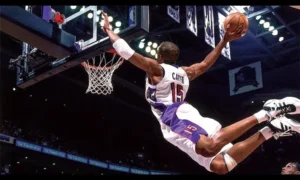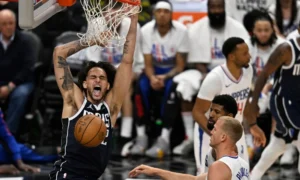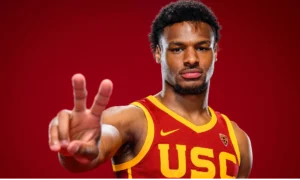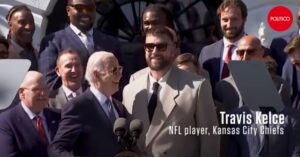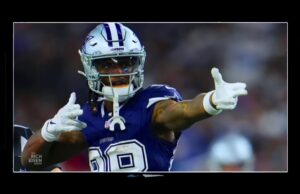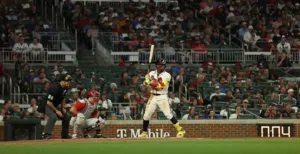2023 NBA Playoff Opening-Round Review - Los Angeles Lakers (7) Taking on Memphis Grizzlies
The Los Angeles Lakers, who remained victorious in their play-in game on Tuesday (April 18, 2023) to claim the seventh seed, will play the second-seeded Memphis Grizzlies in the very opening round of the 2023 NBA playoffs. Although they have never faced off in the postseason, both teams have full prepared for the war.
This image is a video screen grab.
@ Their Positions
The Supreme Memphis Grizzlies (51-31)
The Los Angeles Lakers, who remained victorious in their play-in game on Tuesday (April 18, 2023) to claim the seventh seed, will play the second-seeded Memphis Grizzlies in the very opening round of the 2023 NBA playoffs. Although they have never faced off in the postseason, both teams have full prepared for the war.
By sticking to their game plan of superior defence, passable offence, internal player growth, and strength in numbers to get through a particularly trying couple of months.
Zoom out, and the Grizzlies’ follow-up to their historic 2021–22 season appears to be in good shape: the West’s second-best record and its best net rating, driven by the best defence of this post–Grit ‘n’ Grind era; a nearly top-10 offence with three players who have greatly averaged 20 points per every game down the stretch; though a reserve corps performing the outclass backup point guard in the competition (Tyus Jones); and the league’s top 3-point shooting percentage.
Ja Morant and Desmond Bane led a 9-4 start that also included a defence that was 17th in points gained per possession through the first month.
Bane had a right foot injury that kept him out for more than a month just as Jaren Jackson Jr. was about to make his season debut after missing that month due to right foot surgery.
This slowed down the offence as the JJJ-led defence started to soar.
About a month after Bane returned, starting centre Steven Adams, a possession-game-tilting monster who ranks among the league-leading stars in offensive rebounding, second-chance points, screen assists, and box-outs, went down with a right knee sprain that concluded his regular season and will probably keep him out for the duration of the playoffs.
After about a month, the Grizzlies’ backup big man Brandon Clarke, who was already an important part of the frontcourt while Adams was out, had an Achilles tendon rupture in his left leg, terminating his season.
The Grizzlies only got a brief glimpse of either their preferred starting lineup (Bane, Morant, Adams, Jackson, and Dillon Brooks played just 128 minutes together) or their first-choice backup (the lineup with Clarke taking position of Adams while JJJ slides to the 5 played a pitiful 54 minutes), and won’t have entry to either when the contest matter the most.
The bright side: After March 1, Memphis still held the second-best record in the West thanks to Jackson improving offensively, Bane taking on more of the ball’s responsibility, Morant returning and appearing to be more or less himself, Xavier Tillman doing heroic work in place of Adams and Clarke, and backup forwards Santi Aldama and David Roddy providing reliable stopgap minutes upfront.
The playoff stage, and unambiguously a matchup with one of the supreme players ever and one of the most overwhelming interior pulls for the moment, will reveal how much the Grizzlies miss their injured big men, proving whether those depth pieces are postseason-ready.
But at the base, what was true about Memphis before the season is also true today: They’ll go as far as Morant, Jackson, Bane, and Brooks can take them.
The Great Los Angeles Lakers (43-39)
By ultimately taking the Lakers, returning to the fundamentals, and discovering a fresh lease on life.
We are not here to bury Russell Westbrook because he has successfully helped the cross-Crypto foe Clippers win. Instead, we arrive at the realisation of the significance of things that fit, work, and make sense.
From the first tip, it was evident that the Lakers’ starting lineup didn’t make sense: there wasn’t enough shooting, playmaking, size on the wings, or defensive toughness. and there aren’t enough benefits to keeping Westbrook in the beginning lineup alongside LeBron James and Anthony Davis.
Russ was demoted to the bench by Los Angeles’ first-year head coach Darvin Ham after the team lost its first three games, with Russ shooting a total 11 for 38 in the defeats.
The decision didn’t immediately improve the Lakers’ situation, as they still lost six of their next eight games, but it did signal a change in the team’s priorities and an admission by L.A. brass that, in order to fully utilise AD playing brilliantly at the 5 and LeBron averaging close to 35-8-8 in the month leading up to his 38th birthday as he approached the all-time scoring record
That’s what they did. The Lakers traded six players—most notably Westbrook—along with future first- and second-round draught picks and money in two transactions that occurred a little more than two weeks apart, while also adding six new players.
With two months left in the season, they entirely changed their lineup in an effort to once again surround James and Davis with guys who could shoot, dribble, pass, and defend.
The shuffle paid off, as the Lakers suddenly made sense and looked dangerous once more with D’Angelo Russell enhancing another playmaking and scoring giant who shot 41% from deep, Jarred Vanderbilt featuring with Anthony Davis in a fierce defensive frontcourt, Malik Beasley capable of blowing up from long range off the bench, and Rui Hachimura gathering two-way versatility across the front line.
Even with James missing 16 games, L.A. had the best record in the West and the third-highest net rating following the trade deadline.
The new starting lineup of James, Davis, Russell, Vanderbilt, and exceptionally talented backup Austin Reaves outscored opponents by 37 points in 77 minutes during the final stretch.
The Lakers went from 13th at the trade deadline to seventh at the end of the season thanks to that final kick, the Trail Blazers’ blatant tanking, the Jazz’s less blatant tanking, some commonsense mistakes from the Timberwolves, Pelicans, and Thunder, and a truly catastrophic turn of events in Dallas.
As a result, they only needed to win one play-in game to secure a meeting with the Grizzlies. LeBron, AD, and company now approach the weekend as the clichéd Team You Don’t Want To See In The First Round despite the fact that it wasn’t pretty. Let’s see how they do this time around since that didn’t go so well for them in 2021.
Face-to-Face
The Lakers prevailed 2-1 in the season series.
You might not recall the intricacies of Los Angeles’s 122-121 victory in late January. For instance, Memphis lost an 8-point lead with just over three minutes left, Westbrook scored a game-high 29 points, Morant missed 20 shots, and the Lakers finished the game on a 15-7 run that was capped by Dennis Schröder trapping Bane on the last-second inbound pass, picking his pocket, and sprinting the length of the court for the game-winning and-one layup.
However, you surely recall The Other Stuff from that game. like the portion that included Shannon Sharpe, for example.
Davis missed that contest, one of only 11 in which Memphis fielded its entire starting lineup.
A month later, the Grizzlies returned to Memphis and defeated the visitors, who were playing without James and Russell due to injury, 121-109 thanks to a 39-point triple-double from Morant in the third quarter.
The Lakers returned the favour the next week, winning at home 112-103 despite still being without LeBron and Russell. Davis (30 points, 22 rebounds) was the team’s top performer.
Conclusions
Tennessee Grizzlies
Memphis hasn’t really had a solid finishing lineup to rely on because of all the injuries and missed time.
The revamped starting five, which consists of Tillman and JJJ up front, Brooks and Bane on the wings, and Morant at the point, has been the Grizzlies’ most frequently used five-man unit in the fourth quarter when neither Adams nor Clarke are present.
However, this unit has only played a total of 19 fourth-quarter minutes this year, during which time it has been outscored by 9 points. Not exactly a sample with statistical significance!
Expect head coach Taylor Jenkins to rely on his starting four barring further injuries or foul/other trouble, which is always a risky scenario given that JJJ averages 4.6 personal fouls for every 36 minutes of floor time and Brooks leads the league in technical fouls during the regular season.
This season, the combination of Morant, Jackson, Bane, and Brooks has outscored opponents by a respectable 69 points in 351 minutes, which equates to a remarkable plus-9.9 points-per-100.
While Jackson guards the back line and keeps the rim covered, Morant is the straw that stirs the drink in the high screen-and-roll, and Bane is one of the league’s most lethal catch-and-shoot threats and a competent downhill driver once he beats a closeout.
Brooks serves as the point-of-attack defensive nuisance against the opponent’s top scorer. It can be a very high-variance group, particularly if Brooks is taking shots he perhaps shouldn’t be taking and missing them.
In fact, it hasn’t been great in the season’s few fourth-quarter runs, but you have to dance with the players you have because Adams, Clarke, and a number of other more reliable options aren’t available.
Especially if what brought you is really damn potent and Morant is shredding defenders off the bounce and sinking 3s.
Matchup dependence will likely determine who will join that core. Tillman might be chosen to guard Davis because Tillman has been Memphis’ most consistent defender on Davis this season, holding the Michigan State product to a 9-for-21 shooting clip with seven turnovers.
The two-point-guard approach has been a net negative for the Grizzlies this season, but Jenkins may have more faith in Jones’ years of sure-handed play than those stats.
Tyus Jones has often paired with Morant when the Grizzlies need more ball-handling and shot creation in the crucial moments of the game.
Also keep an eye on Kennard. Since entering the team at the trade deadline, he hasn’t played much with the other starters, but Memphis has annihilated opponents when he and Bane have shared the court. It can be quite difficult for defences to keep up with two shooters who move horribly while running around the floor.
Lonnie Walker IV, who has had more DNP-CDs than appearances over the past month, is part of Los Angeles’ most commonly used fourth-quarter lineup that includes players still on the team. This is due to a number of injuries and the drastic trade-deadline makeover.
Therefore, not much can be learned from the complete five-man squads, much like the Grizz.
However, the way Ham finished the play-in victory over Minnesota is instructive. Davis played the entire fourth quarter and overtime, serving as the backbone of the Lakers’ defence and their most lethal inside weapon.
James played 15 of the very final 17 minutes while still being LeBron Friggin’ James and yet recovering from a damaged right foot tendon.
After the All-Star break, Reaves, a complementing player with size who shot 40% from beyond the arc this season and averaged more than 17 points and five assists per game, played all but 20 seconds of them. With that trio on the court, the Lakers have outscored rivals by 149 points in 390 minutes this season, a trend that has continued into their fourth-quarter surge. When it counts, they’ll be there.
While Russell had provided eight assists and committed just one turnover through three quarters, he was also struggling defensively and had missed eight of his nine shots.
Ham chose Schröder instead, and it paid off because of his quickness and ability to draw fouls. Given that Ja went 9-for-26 against him this season, according to NBA.com’s matchup stats, Schröder is probably L.A.’s strongest defensive matchup against Morant.
It wouldn’t be unexpected if Ham called Schröder’s number again in the closing seconds, particularly if D’Lo’s jumper isn’t working.
As much as Vanderbilt’s length and energy help on the defensive end, playing him offers Jackson, someone, to wander off so he create havoc on the rest of the Lakers’ offence; Beasley demands attention when he’s on, but may damage more than he helps if he doesn’t.
Hachimura, who can switch defensive responsibilities with Davis and James while providing some space and off-the-bounce juice as a lower-tier option, might be the best split-the-difference option. Hachimura also played the majority of the fourth and OT against the Wolves, which may not be a coincidence.
Games U Love 2 C
Who will guard Ja if Ham keeps pulling Schröder off the bench to preserve the late-season starting lineup? Morant’s chances versus Russell or Reaves have to be favourable.
Perhaps Los Angeles decides to put the 6-foot-9 Vanderbilt on Morant, putting length into play at the point of attack.
Vanderbilt was also L.A.’s best defence against Jackson this season; while the concept has appeal, if AD is paired with Tillman and is in charge of backing up everyone else, LeBron would be forced to guard JJJ.
He can clearly compete physically, but do the Lakers want him to do that the entire game? If not, how can they prevent Morant from spiraling out of control and causing havoc?
The Lakers can not make Jackson commit a foul on the other side. It goes without saying that it is critical to keep a favourite for Defensive Player of the Year on the field as much as possible at all times.

